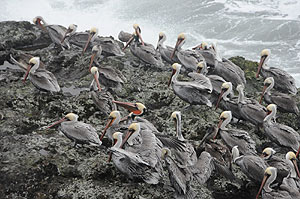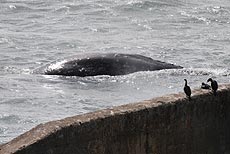 |
Huge Number of Whale Sightings and Pelicans on Oregon Coast
Published 01/21/2010
 |
| The male Brown Pelicans in Lincoln County are showing breeding colors on their necks (photo courtesy Whale Watch Center). |
(Depoe Bay, Oregon) – A run of Brown Pelicans is making a splash in the Lincoln County area, while along the length of Oregon’s coast there are record numbers of whales being spotted.
The recent Whale Watch Week in December recorded unusually high whale sightings, setting various kinds of records.
“It was the highest visitor count in five years, and the highest number of whales spotted in five years,” said Morris Grover, head of the Whale Watch Center in Depoe Bay.
It was possibly an all time high for spotting the great watery beasts. Grover hadn’t received all the data yet, but the Whale Watching Spoken Here group so far had tabulated seeing 672 whales – about double the count of last year’s December whale program.
“We had 9,134 people come by.” Grover said of the visitor count, which was also much higher than usual.
 |
| The Whale Watch Center in Depoe Bay. |
Great weather is the largest factor in all the whale sightings – and apparently the big turnout as well. If seas are calm, as they were that last week of December, the cetaceans will not be hard to spot. They also come a little closer to shore if the surf isn’t going too bonkers, adding to your chances of seeing more.
The whale count is still unusually high, thanks to an abundance of pleasant conditions in January. The Whale Watch Center in Depoe Bay keeps counting from its vantage point, and more than 230 have been spotted these weeks in January - and the month isn’t over yet.
However, you could see the difference when the storms start up.
“On December 30th we spotted 242 whales,” Grover said. “But on the 31st, we saw only two. That was when the storms started kicking in.”
 |
| Whale watching fun (courtesy Whale Watch Center). |
One blustery day in mid-January the center spotted only two whales. The next day, as conditions cleared, 11 were spotted.
Grover said the sightings should be good for a few more days yet – depending on weather – but it will end before the month is over.
The southerly migration of whales happens as pregnant females head to the waters off Mexico to give birth in a warmer climate. They fatten up their young there, so the little ones can gain more blubber to survive in the colder waters near Alaska, and then they begin heading back up during March’s northerly migration.
An unusually large amount of Brown Pelicans is puzzling experts on the Oregon coast, primarily the central coast. Normally, you don’t see so many in so late in the season, said Newport’s Range Bayer, who organizes the Yaquina Birders and Naturalists.
 |
| Pelicans in great numbers on the coast. |
“It is not rare to have Brown Pelicans in January,” Bayer said. “It is rare to have the large numbers in January that are being reported now.”
Bayer’s group reports that among the sightings have been 200 of the pelicans that were spotted at Seal Rock on January 8, 100 spotted at Yaquina Bay’s south jetty, and then 500 more spotted there a few days later. There were an estimated 300 to 400 hanging out in a spot nearby where it was hard to get an accurate count.
“At this point, we are just watching to see what happens,” Bayer said. “If it gets cold and wet, some pelicans may get frostbite like happened along the Oregon coast last winter. There have been cases of pelican frostbite along the East coast in the past, too, so they don't always migrate when they should.”
 |
| A whale near the seawall at Depoe Bay (photo courtesy Whale Watch Center) |
It is speculated they may be trying to nest in Oregon.
“But I don't think Lincoln County has any suitable nesting habitat,” Bayer said.
Also unusual is the fact so many of the males are in “breeding plumage,” meaning the colors on their necks are changing to a black and white configuration – which has been humorously nicknamed a “tuxedo” on the birds.
Since the birds have already survived the apparently coldest parts of the season, as well as numerous windstorms, some in the group believe they’ll simply stick around until when they normally migrate back to this area.More About Oregon Coast lodging.....
 |
 |
 |
RELATED STORIES
Unusual Travel Articles TravelParanormal.com allows you to submit your own creepy tale or debunk one - or see up-to-the-minute news headlines about travel and the paranormal.
Watching Transformations of Oregon Coast Beaches Seasons change and so do beaches, revealing different sides and a variety of eye-popping sights
Staggeringly Cool Ideas for Oregon Coast Romance Be it the season of Valentine's or be it any time of the year, Oregon's coastline has essentially cornered the market for cuddle-inducing possibilities and gushy activities for the hand-holding set
Day or Night Mysteries and Merriment on Oregon Coast It's more than just nightlife that comes to life, but the beaches offer major opportunities
News Headlines from All Over Oregon Need to scan Oregon headlines? Constantly updated news from all over Oregon: a comprehensive, up-to-the-minute display of news headlines from a variety of media.
Secrets of the Season |




































